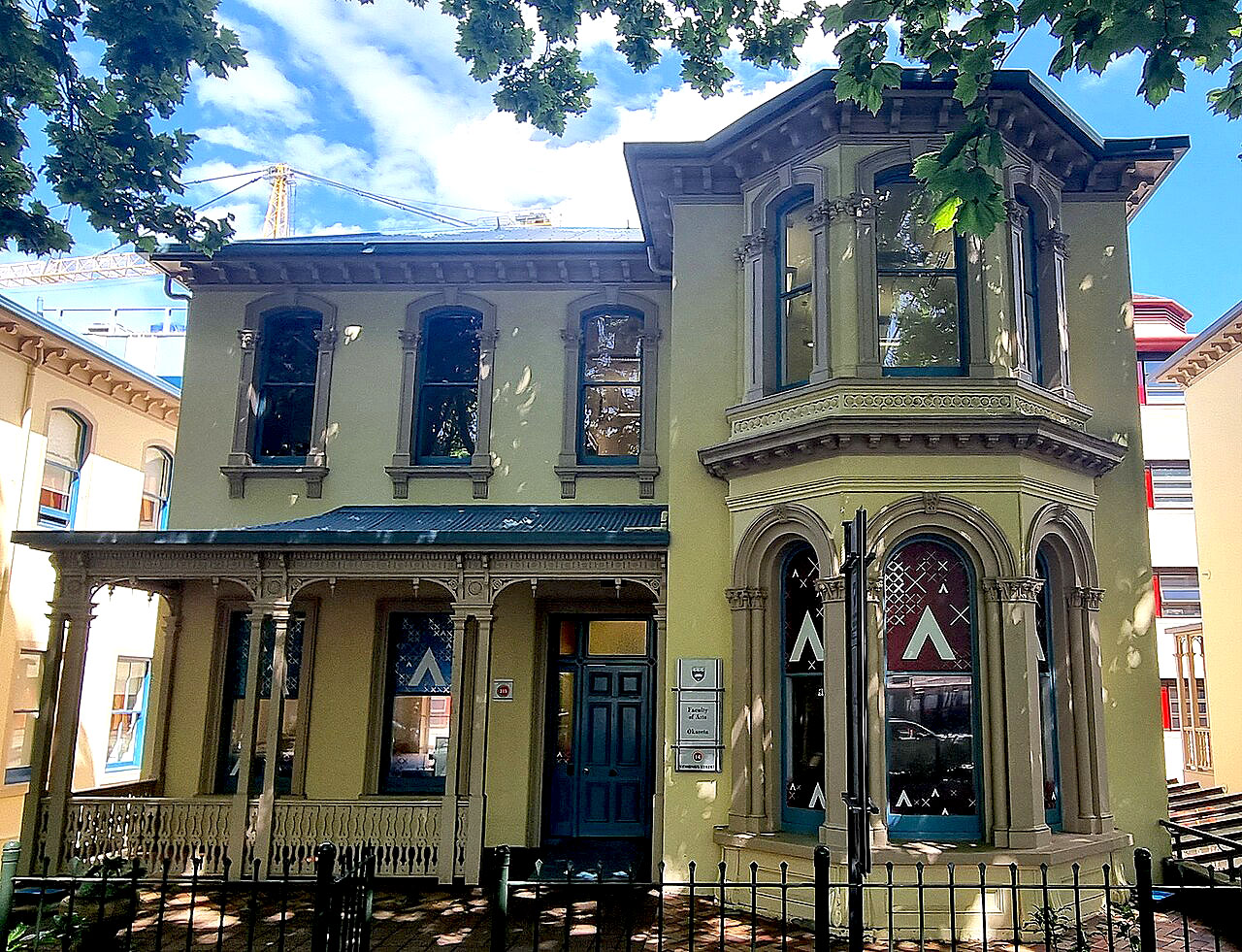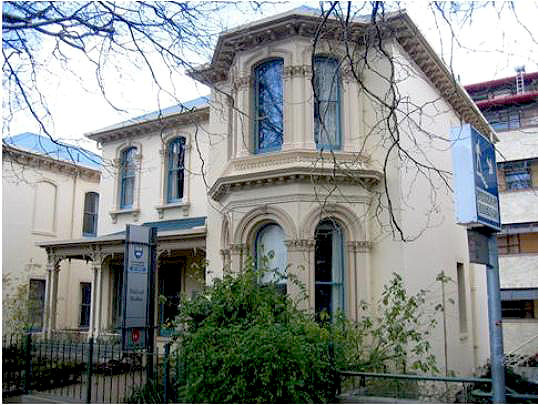The former house at 14 Symonds Street is the middlemost of a group of three adjoining Italianate houses, and reflects high-status urban design in late colonial Auckland. Constructed in 1884, the two-storey dwelling was erected in lower Symonds Street, one of the city's earliest thoroughfares. Prior to the mid 1860s, the Symonds Street ridge was at the epicentre of British colonial power in New Zealand, containing Government House, the Albert Barracks and the General Assembly building. Noted for its ongoing inclusion of high-status institutions such as the Supreme Court, the ridge became increasingly popular as a residential area for the town's commercial leaders in the 1870s and 1880s, after the transfer of colonial administration to the newly designated capital at Wellington and the departure of British troops. The property occupied by the current building at 14 Symonds Street was initially part of an endowment reserved by Governor George Grey under the Grammar School Trust Deed of 1850. By the mid 1860s, timber structures had been erected on the site by a lessee, Charles Pike, described as a settler. As property values rose, the Auckland College and Grammar School Trust sought to improve its income by demolishing existing structures and creating new subdivisions, specifying that dwellings on each property should cost no less than ₤500. In 1884 wine and spirits merchant, Edward Lewis (1835?-1909) purchased the lease for both 14 and 16 Symonds Street for the benefit of his wife Julia (1830?-1912), who transferred half of her interest to a trust for her children by her first husband Charles Davis (1814?-1875). Julia Lewis was mother-in-law to the influential Jewish businessmen Laurence David Nathan (1846-1905) and Alfred Hyam Nathan (1856-1905), while her first husband had also been an eminent member of the early Auckland Jewish community. Funded by Julia Lewis, near-identical new houses were constructed at 14 and 16 Symonds Street by January 1885. Both appear to have been initially built for rental purposes. The house at 14 Symonds Street was constructed in an ornate Italianate design that was fashionable in the 1870s and 1880s, particularly among merchants, whose commercial premises were often erected in a similar style. It was built by William Baildon & Alexander Stevenson to a design by the prominent architectural firm of Edward Mahoney and Sons. Edward Mahoney had earlier been responsible for The Pah, reputed to be the grandest villa in Auckland, and had also recently taken the presidency of the Auckland Institute of Architects. He retired from business in 1885. The asymmetrical frontage of the new villa included a projecting bay and a short verandah, and befitting its financial value the house was built of durable materials, incorporating brick walls and a slate roof. Erected on sloping ground, the building contained two main storeys for reception rooms and bedrooms, with a kitchen and service rooms probably located in a basement. A large garden at the rear may have included a two-storey timber structure and two smaller outbuildings from an early stage. A multi-storey rear verandah on the main house overlooked this area and afforded more distant views across Grafton Gully to the Auckland Domain. The residence was initially let to Auckland Grammar School headmaster Charles Bourne (1850-1913). As head of Auckland Grammar (1881-1893) and Christ's College, Christchurch (1893-1903), Bourne was a significant figure in the development of two prestigious New Zealand secondary schools. During his tenure at Auckland Grammar he developed an efficient organisation, established a school uniform, amalgamated the boys' and girls' schools and significantly improved the institution's academic standing. For a short time, the house appears to have been the residence of former Premier and Attorney-General Sir Frederick Whitaker (1812-1891) before his death in December 1891. By 1900 the residence, in common with a number of substantial homes located in the Symonds Street area, had become a boarding house providing accommodation for single working people and a transient population. This occurred as wealthier citizens increasingly moved to houses in suburban locations. Later known by the name Okareta, the residence was modified in the 1930s and 1950s to incorporate extra rooms for use as flats. Following its acquisition by the University of Auckland in the 1960s, the building housed the Town Planning Department, then the Political Studies Department, its current occupants. Its rear garden and outbuildings were removed by the early 1980s, when a large Arts Building was erected. Alterations were carried out to the main house at a similar time, including the removal of the later rear annex. The former house at 14 Symonds Street is aesthetically significant as one of a cluster of three imposing and ornate Italianate villas, enhanced by its tree-lined frontage to Symonds Street. It is architecturally significant as a surviving example of a two-storey colonial dwelling of urban design, built to house citizens of standing. It is also an example of the work of the noted Auckland architectural practice of Edward Mahoney & Sons. The place has historical value for its association with the conversion of the Symonds Street ridge into a desirable residential district following the departure of the colonial capital to Wellington. It is also of value for its connections with the educationalist Charles Bourne, its probable connections with the former Premier and Attorney-General, Sir Frederick Whitaker, and its associations with prominent early Jewish merchant families.


Location
List Entry Information
Overview
Detailed List Entry
Status
Listed
List Entry Status
Historic Place Category 2
Access
Private/No Public Access
List Number
4489
Date Entered
6th June 2007
Date of Effect
6th June 2007
City/District Council
Auckland Council
Region
Auckland Council
Extent of List Entry
Registration includes the land in NZ Gazette 1967, p.962 (as shown on the 'Extent of Registration' plan in Appendix 3 of the Registration Report), and the structures, their fittings and fixtures thereon, excluding the Arts Building to the southeast and its footprint. The registration includes garden features such as walls, railings and a gate in the northwestern part of the property.
Legal description
Allot 34 Sec 9 City of Auckland (NZ Gazette 1967, p.962), North Auckland Land District
Related listings
Stay up to date with Heritage this month
